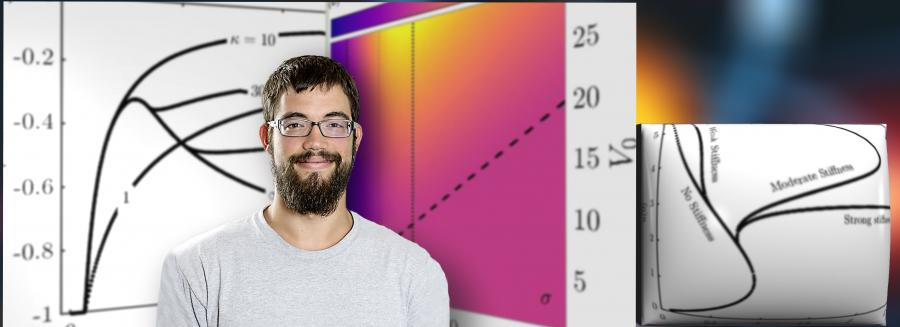Apr 29 2020
When it comes to capturing and managing fusion energy on Earth, scientists often find it difficult to maintain the stability of plasma and to keep it millions of degrees hot, to launch and sustain the fusion reactions. Incidentally, plasma is the electrically charged gas that drives the fusion reactions.
 Physicist Eduardo Rodriguez with images from paper. Image Credit: Photo and composite by Elle Starkman.
Physicist Eduardo Rodriguez with images from paper. Image Credit: Photo and composite by Elle Starkman.
The difficulty lies in the regulation of magnetic islands, which are bubble-like structures that develop in the plasma available in doughnut-shaped tokamak fusion facilities.
These magnetic islands can increase in size, cool down the plasma, and cause disruptions—that is, the abrupt discharge of energy preserved in the plasma—that can stop the fusion reactions and considerably impair the fusion facilities that accommodate them.
Improved Island Control
A study performed by researchers from the U.S. Department of Energy’s (DOE) Princeton Plasma Physics Laboratory (PPPL) and Princeton University points toward better regulation of the vexing magnetic islands in ITER—the international tokamak being constructed in France—and also other forthcoming fusion facilities that cannot permit massive disruptions.
This research could open the door to improved control schemes previously deemed unobtainable.
Eduardo Rodriguez, Study First Author and Graduate Student, Princeton Program in Plasma Physics, Princeton University
The findings were reported in the Physics of Plasmas journal.
This study follows up on an earlier work performed by Allan Reiman and Nat Fisch, who discovered a novel effect known as “RF [radio frequency] current condensation” that can significantly allow the stabilization of magnetic islands.
The latest article, published in the Physics of Plasmas journal, shows the optimal utilization of this new effect. Reiman is a Distinguished Research Fellow at PPPL, while Fisch is a Professor and Director of the Princeton Program in Plasma Physics at Princeton University and also an Associate Director of Academic Affairs at PPPL.
In fusion reactions, light elements are integrated in the form of plasma, which is the state of matter made up of atomic nuclei and free electrons, to produce large amounts of energy in stars and the Sun.
Globally, researchers are looking for ways to recreate the process on Earth for an almost unlimited supply of clean and safe power to produce electricity for all mankind.
The latest article, which is based on a streamlined analytical model, targets the application of RF waves to warm up the magnetic islands and fuel the electric current that causes these islands to reduce in size and vanish.
Under sufficiently high temperatures, intricate interactions can take place that result in the RF current condensation effect. This condensation effect, in turn, concentrates the electric current in the middle of the magnetic island and can considerably enhance the stabilization.
However, when there is a rise in the temperature, and the temperature gradient between the hot interior and the colder edge of the magnetic island becomes larger, the gradient can cause instabilities that render it harder to further raise the temperature.
Point-Counterpoint
This point-counterpoint happens to be a significant indicator of whether the RF waves will achieve their goal of stabilization.
We analyze the interaction between the current condensation and the increased turbulence from the gradient the heating creates to determine whether the system is stabilized or not. We want the islands not to grow.
Eduardo Rodriguez, Study First Author and Graduate Student, Princeton Program in Plasma Physics, Princeton University
Keeping these instabilities in mind, the new article demonstrates how to regulate the power, as well as to apply the waves to optimally utilize the RF current condensation effect.
“Focusing on this can lead to improved stabilization of fusion reactors,” added Rodriguez.
The scientists are now planning to add new aspects to this model, so that more in-depth analysis can be developed. These steps include studies being performed in which the condensation effect would be included in computer codes to model the behavior of the launched RF waves as well as their real effect. Eventually, the method would be used for devising optimal island stabilization schemes.
The Program in Plasma Physics is a graduate program at Princeton University, which is academically situated within the Department of Astrophysical Sciences. The study was financially supported by the DOE Office of Science via the Department of Astrophysical Sciences and PPPL.
Journal Reference:
Rodriguez, E., et al. (2020) RF current condensation in the presence of turbulent enhanced transport. Physics of Plasmas. doi.org/10.1063/5.0001881.